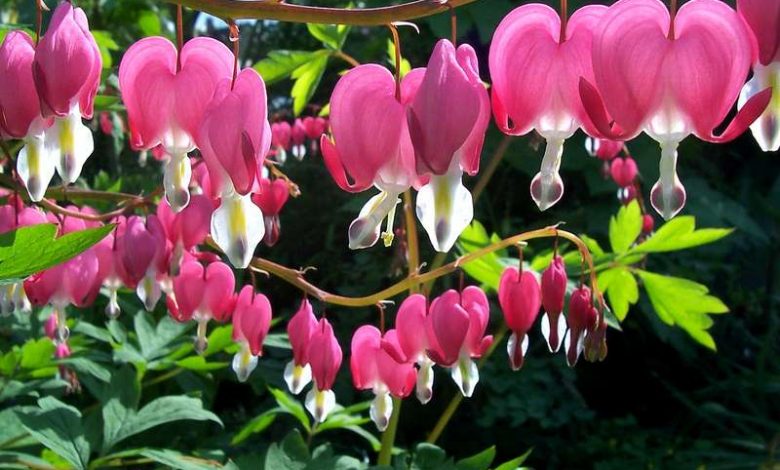
A perennial plant reminiscent of romantic gardens, the heart of Mary ( Dicentra spectabilis ) reveals in the cool massifs or at the foot of a wall in the shade its adorable little pink or white hearts so graceful in spring.
Heart of Mary Flower, a romantic perennial
If the amply arched stems on which the pretty hearts are suspended break like glass, suggesting an apparent fragility, Dicentra spectabilis is nevertheless indeed a rustic and robust perennial, capable of thriving in the garden for many years without the slightest problem.
Once in place, its rhizomatous stems spread quickly and the plant forms dense clumps, 60 cm high, ideal for ground cover.
Its finely cut foliage is the ideal decorative complement to this amazing flowering.
Besides the true heart of Mary (Dicentra spectabilis), there are several close species and many cultivars obtained by hybridization of Asian varieties. (to see further).
Where to plant the heart of Mary?
Dicentra spectabilis likes cool, humus-rich, lime-free soil, preferably neutral. Plant it in partial shade. The deciduous flowers and foliage are most beautiful and long-lasting in light shade, especially in the late afternoon.
The hearts of marie are superb in perennial beds, under the cover of a tree or to compose English-inspired mixed-borders.
They also do well in large pots; they are then used as part of seasonal decorations, in a courtyard, a patio or a shaded terrace.
How to plant it?
Plant it in the fall and at the latest in early spring to enjoy flowering from the first year. Mix a good handful of compost or horticultural compost with the original soil and plant tightly, at the rate of 3 to 4 plants per square meter, but without burying the collar. This makes it possible to obtain a ground cover effect more quickly. Protect from slugs immediately.
After planting, spread a thick organic mulch (grass clippings or shredded branches) to keep the soil fresh longer.
What maintenance to perform?
Any ! You can simply remove the flower stalks as soon as they start to turn yellow at the end of flowering to give the clump a little more allure. In February, clean the dried leaves.
Early in spring or at the end of winter, watch for slug and snail attacks. Young shoots are the most fragile.
In summer, water very regularly without wetting the foliage. The heat strokes push Marie’s heart to go into dormancy more quickly.
Avoid moving it: once installed, the fibrous roots of Marie’s heart do not appreciate being jostled!
The young shoots can burn in the event of a late frost, without this constituting too great a trauma for the future development of the plant.
How to multiply the heart of Mary?
Divide the stump in early spring, just before the young shoots restart. Divide into shards, each with several buds. Replant immediately in a pot or elsewhere in the garden. Water regularly, without excess, to help recovery.
A poisonous plant
Beneath this romantic allure hides a formidable poison! Don’t panic, just remember to handle the plant with gloves or wash your hands well afterwards.
Recommended varieties
Dicentra spectabilis
This is the classic heart of Mary , the most common in the garden. 60 to 90 cm high, it reveals from late spring pretty pink and white hearts hanging from long arched stems. Leaves drop soon after flowering. There are also several varieties:
- Dicentra spectabilis alba: the white heart of Mary, stands out for the entirely white color of its flowers and for its dark green foliage.
- Marie Valentine’s Heart (Dicentra spectabilis valentine): a plant with brick-red and white heart-shaped flowers that are paired with beautiful bluish-green leaves. To be grown in shade or partial shade, Flowering in April-May, Height: 80 cm.

Dicentra « bacchanal »
Bushy Heart of Mary , approximately 45 cm high and 60 cm wide. Its light green foliage bears a curious resemblance to that of ferns. Its honey-scented, pendulous heart-shaped flowers are deep burgundy in color. Use it as a ground cover for heather plants.

Dicentra «langtrees»
This vigorous cultivar forms large clumps (30 cm high for 45 cm spread). From May to July-August, its very jagged bluish foliage is topped with creamy white flowers.
Dicentra formosa
It is a crawling heart of Mary (45 cm in height, 30 cm in spread). From spring and summer, its fine arched stems let bloom pink and red, even white (alba) flowers. This heart of Mary is ideal at the foot of Japanese maples or along a shady path.
Climbing dicentra, dicentra scandens
Not a true heart of Mary but a close species. Its voluble stems fitted with tendrils (1.50 m to 3 m high) cling to any available support: shrub, trellis, fence, tepee…

Its abundant green foliage perfectly highlights its elongated yellow hearts, with a green or orange tip, which bloom from May until autumn. This climbing heart of Mary is more chilly than the classic species: protect its stump in winter.
